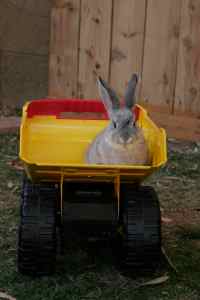
Many people raise rabbits for fun, food, profit, and more. Rabbits are relatively easy to care for – as compared to common pets and livestock – and require fewer resources for their care. They are also multi-functional on the homestead, farm, or just in the suburban or urban home.
There are many reasons for raising rabbits, but for the gardener, one stands out above the rest: rabbit pellets (aka manure). Rabbits produce a lot of it and have the added bonus of consuming your leftover or otherwise-composted garden refuse, making it usable fertilizer far faster than your compost pile could ever do.
If you’re interested in keeping rabbits for your home and garden, read on.
Raising Rabbits in the City
Whether you live in the suburbs or downtown in an apartment, you can likely keep rabbits. Your space and legal allowances (the law, rental agreements, etc.) will determine how many you can have (or will need). If you have a container garden of a dozen plants, one rabbit’s output will be about a lot more fertilizer than you’ll really need through the year. If you get a rabbit and have container gardening neighbors or friends, you’re about to become their best friend.
Be aware of the restrictions in your area, especially on keeping and harvesting (slaughtering) rabbits. This is often heavily regulated within the city limits. Keeping rabbits as pets usually has few restrictions beyond what your landlord might have to say. If you plan to keep several rabbits and to do so outdoors, however, then more zoning restrictions could come into play. Again, know the rules before you get your first rabbit.

Caring for Rabbits
For the most part, rabbits are relatively hassle-free. You can feed them commercial rabbit feed, available at many grocery stores, home stores, and pet stores. Primarily, though, you should feed your rabbit leftover vegetables (without garnishment) and trimmings from your kitchen. For instance, rabbits love the leafy tops of carrots, the cutaway stubs of onions, the somewhat wilted lettuce leaves you peel off, apple cores, iceberg lettuce cores, the leafy parts of celery… Just about anything.
Be aware of what your rabbit can and cannot eat, of course, but most anything vegetarian will be fine for rabbits.
Housing is the next concern. You’ll want a spacious coop or hutch with a closed-in, small, cozy private area for sleeping and hiding when something scares the rabbit. Many rabbit owners let their rabbits roam free through a room or the whole house, but be prepared for “surprises” as with any other pet and for the nibbler to go through cords and even drapes. Many pet stores sell playpens for bunnies so that they can have a large area to move about in without being a danger to themselves or your home.
The last thing is catching and utilizing the manure (or pellets). Most rabbit cages meant for indoors will have holes in the floor and a catch pan underneath or some sort of system for easily cleaning the floors into a container so you can harvest the rabbit manure every day or couple of days.
Rabbit Breeds for Inside or Backyard
There are dozens of breeds to choose from, boiling down to general categories. Most indoor or backyard keepers will be interested in dwarf, miniature, and medium-sized breeds. There are many of them and they range from 3 pounds (dwarf) to 10 pounds or so (medium). If you plan to raise rabbits to eat, then you’ll want to check on meat breeds as well (8-12 pounds). The bigger the rabbit, the more it will eat and poop, of course, so choose wisely.
Using Rabbit Droppings in the Garden
This is where the gold is for most gardeners interested in rabbit keeping. Rabbit pellets can be used in several ways. The most common is to pour it (along with some wash water and urine) directly onto plants. If your cage requires that you wash the pellets and urine out and into a container, then this is probably how you”ll use it most often. You can also mix this directly into soil mixtures when starting plants or building new planting soil.
Another option is to compost it. Just add the pellets (and possibly litter, like straw) to the compost bin or pile as you would any kind of manure.
Finally, the pellets themselves, if dry, have the unique property of being easily handled. So you can bury these directly into the soil around your plant’s roots. A good way to do this is to poke a hole in the soil with a screwdriver or pencil, drop in a couple of pellets, and repeat all around the plant.
Learn more about rabbits
Raising Rabbits: A PDF from Kansas State University Cooperative Extension Service
Choosing a Rabbit Breed: A link to a PDF by Michigan State University Extension.

I have been collection my rabbit pellets for the past couple of weeks and have several bags, ready for the garden. I have used pellets on my indoor plants with great success. Now for the garden. I can’t wait to see how this will make a difference in my plants.